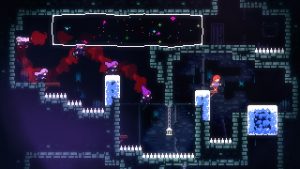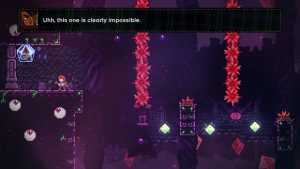Celeste is the latest indie game to try to add a deep story on top of a genre we’ve seen before, with its combination of challenging gameplay and introspective story about one’s self worth. In an attempt to tell the story, I feel like the design doesn’t quite keep up.
An Uphill Climb:
The story of Celeste follows a girl who is trying to climb the Celeste Mountain for reasons we don’t know at the start. While things start out normal, they quickly begin to take a turn for the weird as she is confronted by her dark self and the mountain climb takes on a mind of its own.
The platforming gameplay of Celeste has been refined to a tee. Your controls are limited to move, climb, jump, and performing an air dash. You can only climb for a limited time and perform one air dash before needing to land on a surface.
Your mission is to get to the end of each area and move on to the next chapter. While you will die a lot, checkpoints occur at the start of each room. To its credit, each chapter of Celeste introduces some kind of environmental hazard or rule-impacting mechanic that changes up the platforming for each level.
The interesting point of Celeste’s design comes down to its difficulty, and how the designers tried to truly make a game for all skill levels.
Setting a Goal:
Celeste was a game that was designed to be accommodating towards everyone in terms of skill level at platformers. The basic path through Celeste in my opinion is on the medium-hard side; not quite Super Meat Boy, but still above Mario. If you’re having trouble or want a higher challenge, the game offers different options.
The title’s “Assist Mode” will probably be talked about for the rest of this year in terms of accessibility.
Turning on assist mode allows the player to tweak the gameplay to make it easier, but it’s not quite that simple. You can change various aspects of playing Celeste at any time to help you out.
Are you having trouble with timing air dashes? Then turn on bonus or infinite dashes. Game too fast for you? You can slow down the gravity and game speed. You can literally unlock every stage and play through them with invincibility.
For the challenge side of things, Celeste offers several hurdles. Every chapter has strawberries placed in hidden areas or hard to reach parts of the room. You need to collect the strawberry and get back to safety in order to collect it. The strawberries will always require advanced understanding of the challenge in order to get them, but offers no in-game reward for getting them.
Hidden in each chapter is a cassette tape that unlocks the “B-Side” of that chapter. B-Side versions of each chapter give you a brand new, and harder, stage to complete. Think of them as the nightmare versions of the levels like in Super Meat Boy. And for those wanting even more of a challenge, there is a third difficulty unlocked after beating the B-Side.
All in all, I think this was a great idea for Celeste and an important option for game designers to think about going forward. While I don’t think every game’s design could work in this manner, for the ones that do, it allows the game to be as easy or as hard as the player wants.
My main problem is that for all the ways Celeste tries to push forward in terms of accessibility, it doesn’t do all that much with design.
Shaky Footing:
Celeste is not a bad game by any means, but it’s an example of a game stretching its mechanics beyond the breaking point.
My main problem with Celeste comes down to the actual level design. There is an understated element of good level design and knowing how much you can do with the mechanics at hand. At some point a level will go on for so long that it just feels like you’re repeating the same sections.
Celeste was designed around having a standardized, and locked move-set; with the environment of each chapter adding variety. The problem I felt was that “the twist” of each level ran out long before the actual level did.
Instead of introducing more varied sections, the difficulty goes up by extending the length of a room. This changes the dynamic of the game similar to Super Meat Boy’s final world; in that the player must master a longer section or be forced to repeat the same thing. However, it started to feel like I was just doing the same thing over and over again.
Later chapters felt like they could have removed a few rooms without the player noticing it. It wouldn’t be so bad if the different sections mixed things up, but it was all just variations on the same design.
I also felt the difficulty curve within each stage wasn’t as on point compared to the design. There were some sections that to me were harder than ones that would come after it. I was also surprised considering the developers’ intention of accessibility with Celeste that the game could have done a better job in my opinion of explaining “the twist” for each chapter.
If you grew up playing platformers; especially indie ones, you’ll have everything you need in terms of a knowledge base to play Celeste. However, people starting at zero may struggle learning how each mechanic is supposed to work. I would honestly not recommend Celeste if you are completely new to platforming, as I don’t feel the game does a good enough job of explaining itself and the mechanics.
I never felt like I was actually growing in terms of skill and knowledge at the game; just figuring out what the game wanted me to do in each room before moving onto the next. It just felt like variations on the same theme as opposed to an escalating difficulty and complexity curve.
The game also commits a level design sin: Waiting until the literal last level of the last difficulty of the game to introduce a never before hinted at mechanic without any chance of practicing it safely.
An Uplifting Experience:
Celeste is a great platformer that is built to provide a challenge to as many different people as possible. If you’ve looked at the platformer genre before and felt that it was too high of a challenge for you, the assist mode in Celeste will guarantee that you see this mountain climb to the end.
However, people starting out completely fresh may want to try a smaller incline to scale first. For more on the game, you can watch my videos of it on the Game-Wisdom YouTube channel, and the dissecting design below.





